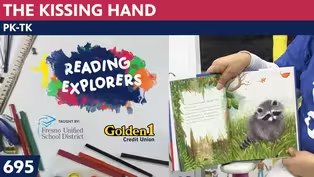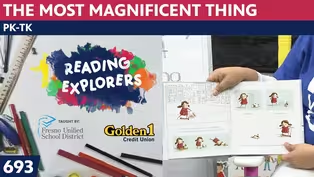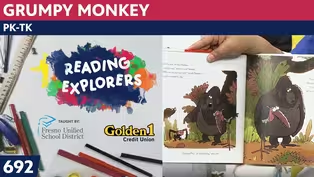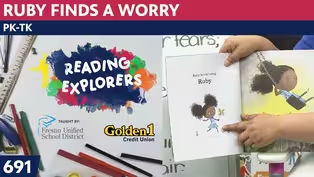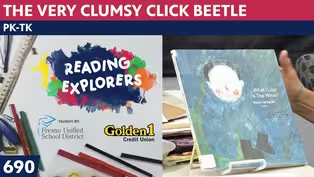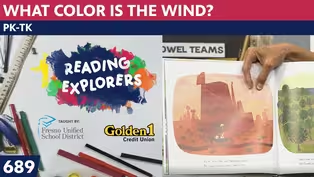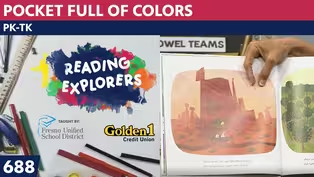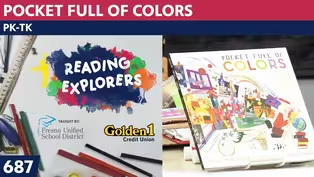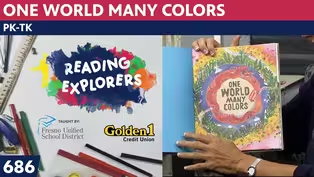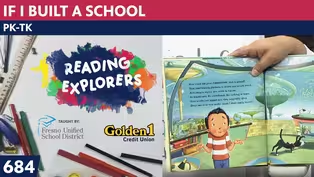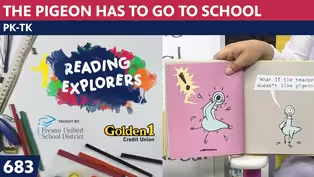
TK-377: Painting with scissors with Charley Harper
Season 3 Episode 433 | 14m 11sVideo has Closed Captions
Join Mrs. Readwright at Camp Discovery!
Transitional Kindergarten teacher, Mrs. Readwright, welcomes students back to Camp Discovery, a fun learning space packed with reading adventures & fun games!
Problems playing video? | Closed Captioning Feedback
Problems playing video? | Closed Captioning Feedback
Reading Explorers is a local public television program presented by Valley PBS

TK-377: Painting with scissors with Charley Harper
Season 3 Episode 433 | 14m 11sVideo has Closed Captions
Transitional Kindergarten teacher, Mrs. Readwright, welcomes students back to Camp Discovery, a fun learning space packed with reading adventures & fun games!
Problems playing video? | Closed Captioning Feedback
How to Watch Reading Explorers
Reading Explorers is available to stream on pbs.org and the free PBS App, available on iPhone, Apple TV, Android TV, Android smartphones, Amazon Fire TV, Amazon Fire Tablet, Roku, Samsung Smart TV, and Vizio.
Providing Support for PBS.org
Learn Moreabout PBS online sponsorshipMore from This Collection
Valley PBS and Fresno Unified School District have partnered with Golden 1 Credit Union to create Reading Explorers Lessons for grades Pre-Kindergarten through Third grade. The daily lessons will be taught by Fresno Unified School District teachers and are created to help students practice their reading skills and reinforce lessons during distance learning.
Video has Closed Captions
Valley PBS presents Reading Explorers Lessons for Pre-Kindergarten and TK. (26m 27s)
PK-TK-693-The Most Magnificent Thing
Video has Closed Captions
Valley PBS presents Reading Explorers Lessons for Pre-Kindergarten and TK. (26m 26s)
Video has Closed Captions
Valley PBS presents Reading Explorers Lessons for Pre-Kindergarten and TK. (26m 28s)
Video has Closed Captions
Valley PBS presents Reading Explorers Lessons for Pre-Kindergarten and TK. (26m 28s)
PK-TK-690: The Very Clumsy Click Beetle
Video has Closed Captions
Valley PBS presents Reading Explorers Lessons for Pre-Kindergarten and TK. (26m 22s)
PK-TK-689: What Color is the Wind?
Video has Closed Captions
Valley PBS presents Reading Explorers Lessons for Pre-Kindergarten and TK. (26m 21s)
PK-TK-688: Pocket Full of Colors
Video has Closed Captions
Valley PBS presents Reading Explorers Lessons for Pre-Kindergarten and TK. (25m 58s)
PK-TK-687: Dancing Through Fields of Colors
Video has Closed Captions
Valley PBS presents Reading Explorers Lessons for Pre-Kindergarten and TK. (26m 20s)
PK-TK-686: One World Many Colors
Video has Closed Captions
Valley PBS presents Reading Explorers Lessons for Pre-Kindergarten and TK. (27m 13s)
PK-TK-685: School is Wherever I am
Video has Closed Captions
Valley PBS presents Reading Explorers Lessons for Pre-Kindergarten and TK. (26m 32s)
PK-TK-684: If I Built a School
Video has Closed Captions
Valley PBS presents Reading Explorers Lessons for Pre-Kindergarten and TK. (26m 21s)
PK-TK-683: The Pigeon Has to Go to School
Video has Closed Captions
Valley PBS presents Reading Explorers Lessons for Pre-Kindergarten and TK. (26m 22s)
Providing Support for PBS.org
Learn Moreabout PBS online sponsorship- [Male Singer] ♪ Good morning to a brand new day ♪ ♪ Time to learn and games to play ♪ ♪ Learning things is so much fun ♪ ♪ Learning is good for everyone ♪ (playful music) - Hello, early learners.
And welcome back to the art room where we are studying the artist Charlie Harper.
Now let's start out with our hello song and then we'll talk about what happened yesterday and find out what we're doing today.
♪ Hello, nice to see you, everyone ♪ ♪ Hello, nice to see you, everyone ♪ ♪ Hello to you ♪ ♪ Hello to you ♪ ♪ Hello to you ♪ ♪ Hello to me ♪ ♪ Hello, nice to see you everyone ♪ Alrighty, yesterday we made the Cardinal and I let time get away from me and I barely finished it, but I brought it and put it on the chart today, so you can see it right out on the corner.
I didn't add the footprints or the sunflower seeds yet, but here he is.
And he's standing there with his striped tail and his wing feathers are drawn and I put a little orange on his beak.
So if you decide you'd like to do that, you're ready to go.
All right.
So today we are meeting the Robin.
The Robin is one of the first birds I ever learned as a little girl because they hop around in your yard quite a bit.
And you can really recognize them because their chest is red and they call him or her because both birds have that coloring, little Robin Redbreast and we're going to sing about it.
And I wrote this song and I wanted to tell you because when a bird builds its nest, a lot of what they put in there are sticks and the sticks are kind of sharp.
So when they go to sit on the sticks it doesn't really feel that comfortable.
So you find that birds will find grasses or little pieces of shredded paper or things like that.
And this bird is putting a heart shaped piece of newspaper in the bottom to make the bottom soft.
And there's a little picture of a bird on it.
That must have been an ad in the newspaper.
So here's the song.
And it goes like this.
♪ Which bird is this ♪ ♪ The Robin I love best ♪ ♪ He's adding a newspaper heart to soften up his nest ♪ And I want you to see that his body is like a half circle.
And his head is like a thumb print with a little gray collar around it that's like a triangle, and its wing is a rounded triangle.
And its tail is another kind of flattened triangle.
So I'm going to bring this down to my desktop to use it as our inspiration.
Come on Robin.
Now, I also wanted to tell you a little bit more information about Charlie Harper.
When I looked up about Charlie Harper it said he was a wildlife artist.
That means anything that lives in the nature that no one has in a cage.
He didn't want to cage things up.
He wanted them to live in nature and be wild.
And it doesn't mean the wild like (roaring), it just means it's out not being trapped.
So he was a wildlife artist who used geometric shapes, circles, squares, rectangles, triangles, but he also did it in symmetry.
And we talked about how one side looks like another especially if you look right at the bird, it's very symmetrical and it has two wings, wing on this side wing on that side.
If it has a beak, the beak is up here, the beak is down here.
So there's two, two, two, two a lot of things on a bird, two legs.
So let's see how he made this Robin.
I brought as my background paper, a piece of blue paper.
Let me remove my clipboard.
I think that's going to be bothersome.
And the pointer stick.
One minute boys and girls, sorry for that delay.
All right.
So I have black because you can see on his wing, he has kind of a blackish grayish wing.
His head, see how it looks kind of like a thumb print if you draw around your thumb, depending on how big your bird is going to be.
'Cause everybody will make theirs a different size, I'm sure.
You see, I have the red for its red breast.
I have gray for its little gray scarf and it has kind of a gray back and tail with a piece of black on it.
But I might draw that with my black permanent pen.
I brought two kinds of gray because I saw one darker gray and one lighter gray.
So we'll see.
And its eye is white.
So I better get a piece of white out of my box of papers and have it up here.
How we make a white eye.
All right, let's start out by making the half circle body.
Now I can just cut mine.
If you want to put the edge of a paper plate or something on there to make it be a certain shape and size, you can do that, but I'm just going to cut it.
And if you wanna be like me, just you cut it too.
Just be brave.
And I'll put it on this piece of blue paper so you can see where I'm going.
Now, I need to look at my inspiration right side up so I can see, boys and girls, but I'll keep turning it back and forth to you.
That's the body part.
And then I'm going to do a gray head.
So I have to see how big the head will be.
So I can do my thumb like that, and I see it is.
So I will put my thumb on here and I will cut around my thumb and see if that head size is the right size.
I can put it on here.
Oh, I made it a little too big so I will make it smaller and just trim it down, here.
That looks pretty good.
Put it on its back like that.
Pretty good.
And then I can just use it with my black piece of paper because you can see where the gray scarf is where I put that, but I have to make this part black.
So I'm going to put glue on my head from this little point and all over that curve thumb part, and I will put it.
Oh, I think I put the glue on the wrong side.
Nope, I didn't.
And I will put that on my black piece of paper and have it be down.
Then I'll just trim around it to make the head.
If you think that you need to just cut out the head a certain way, if you want to just keep it gray, that it seems too hard to keep doing the other pieces, you can do that too.
But look how that happened.
When I cut it around, it made a perfect one.
And we know that his wing is a triangle.
So I'm gonna put it on his body and just do a rectangle first.
So I have the size, you know if this gets going fast, I heard Ms... Whose class was that?
Ms. Ornela's class at Del Mar.
I watched them as they were doing their art and watching the program during class.
So what she did was she would play it, but then when they got behind, she just paused it and let them work on the piece that seemed to be going too fast.
So you can do that too.
Just stop the video, pause it, and come back to it.
I'm gonna put the wing on so I don't lose it.
And I think I'll glue the head on, so I don't lose it.
There, all of it's coming together.
See my bird?
Now it looks like I need its gray tail with the black lines on it.
So I can just put it on here and measure how long I want my tail to be.
And if this is a time where you want to use a pencil this might be a good time.
Let me look at my inspiration so I can see.
It goes up from its bottom, from its bottom straight up.
So I'm gonna put it here and from its bottom I'll just go straight up.
Then it curves back down in a triangle to the back of it and meets up with the little scarf.
So I'm gonna draw down, make a dot to where how far down the bird goes.
And I can just cut it down.
I said, well, how far does it need to go?
Oh right there.
And since it goes in the back of the bird I can just cut it off.
I'm gonna put it there.
I bought this book that shows you how to draw these kinds of birds.
But when I went to the mailbox it didn't come when it said it was going to come.
So I couldn't bring it today.
But I will bring it when it comes in the mail.
It said it was going to come on April 28th, but it didn't.
And I thought, oh well, I guess I'll have to wait for it.
Okay, boys and girls, I'm going to put the orange beak on and draw the black marks on it.
Cause I think I'm finished cutting and pasting at this point.
Get out of here you people.
Where did I put my little orange piece of paper?
Is it hidden in there?
Oh, I can see the scraps right here.
And you know, the beak is just a triangle.
So I'm going to cut a long skinny triangle, put it on its face, and I know it's too long, but if I scoot it up behind its face, it looks good.
It has a place open between it because that's where it's holding onto the newspaper heart.
So I'm going to cut my triangle from the point all the way to the end.
And then in front of its face, I will put glue stick and slip it in there so I can see exactly where how far down I need to make it.
So I put that little beak there.
I put this little beak to match it.
And that way I can put the little newspaper heart on the bird's beak.
I need to put a little more glue, it's sticking to my finger instead of the paper.
And you can see in back of my bird all the places where the pieces are meeting.
Let me show you the back.
See I have that overlapping, but when you put it down on my paper, you don't see all those pieces in the back.
I am going to cut out its eye and put the black dot in it.
So let me get the white paper and measure how big a piece.
And I look and say, I hold it up to my bird's face, so I can see how big a piece I need.
That's about right.
And I will cut the corners off, just like we learned how to do for the human eyeballs when we've been doing art in the past.
I'll put the glue on it and get my permanent pen ready to make the pupil inside the eye with a round circle.
I'll put that, it has a ring around it.
So, oh, the glue is still too wet and it was starting to move my circle around, and color that in.
And then I have to get my little piece of newspaper and they have this one torn out.
I drew a little heart on here.
I could just fold it in half and do it that way.
I think that would be easier.
If you want to cut it, you can.
I'm doing it kind of like the artist did and make it a torn piece.
So I'm going to open it up and that's perfect for me.
And I'll put it in his mouth so he can put it in the nest when it comes time, glue it.
I better put it more on the heart shape, boys and girls.
It looks like we're coming to a close in a minute.
Anyway, remember same materials, glue, scissors, black pen and you will be ready to make the bird we're going to make tomorrow.
I'll put a little glue on the back of his tail and get it stuck on here so I can show you how I'm going to do those feathers before we say goodbye.
Here we go.
And on this one, it just shows the feathers on the tail going down.
So I'll just go down.
The tail feathers are down like this and like that.
Okay, well now, he just needs a couple of legs and they have the bird standing with its legs this way kind of forward with the knees on there, like that.
All right, boys and girls let's sing goodbye.
♪ See you next time, everyone ♪ ♪ Goodbye, see you next time, everyone ♪ ♪ Goodbye to you ♪ ♪ Goodbye to you ♪ ♪ Goodbye to you ♪ See you tomorrow.
Goodbye boys and girls.
(guitar music) - [Male Singer] ♪ Good morning to a brand new day ♪ ♪ Time to learn and games to play ♪ ♪ Learning things is so much fun ♪ ♪ Learning is good for everyone.
♪
Support for PBS provided by:
Reading Explorers is a local public television program presented by Valley PBS
